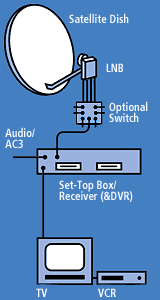Digital TV: An Easygoing (R)evolution
TV Markets In USA And Europe
Today there are three major analog TV standards: NTSC (America), PAL and SECAM. The move to digital represented a unique opportunity to replace these different analog standards with one new and universal digital TV standard. But this dream has not come true, due mainly to the differences in TV culture, history and broadcasting structures worldwide.
Worldwide analog TV standards.
The local TV markets in USA and Europe grew in very different ways over a long period of time. The different countries in Europe are much smaller than the USA. Most European countries have major TV broadcasters under public law, competing with relatively young private companies in a common, state-wide TV structure. In the US, on the other hand, there are a lot of regional TV stations combined with only a few nationwide broadcasters. Most of the regional broadcasters in the US own just one or two transmitters, expect for overcrowded areas. Receiving those channels via antenna is free, since broadcast TV stations make their money by advertising.
Going with cable means that you have to sign up with one of the big cable companies and pay a monthly fee, depending on the TV package you like and whether you combine the service with broadband Internet access. TV stations still rely on advertising, except for special pay TV stations like HBO, Disney and video-on-demand offerings.
The satellite TV market in USA is comparatively young. Satellite always comes with costs for the content, but its big advantage is the huge number of available TV channels and the ability to view regional channels from anywhere in the country.
Signals from outer space - Setup of a satellite TV installation.
The TV market in Europe has different parameters. First, in most countries, the viewer receives the same channels nationwide. Analog antennas are not used anymore in most modern European countries. If you're going with a cable provider, you can sometimes also receive a few regional channels. Satellite TV is very successful and widely used, since cable is not available everywhere, and you need to pay a charge to use it. With satellite, you can receive hundreds of free-to-air channels (even digital) depending on the satellite and country.
Get Tom's Hardware's best news and in-depth reviews, straight to your inbox.

